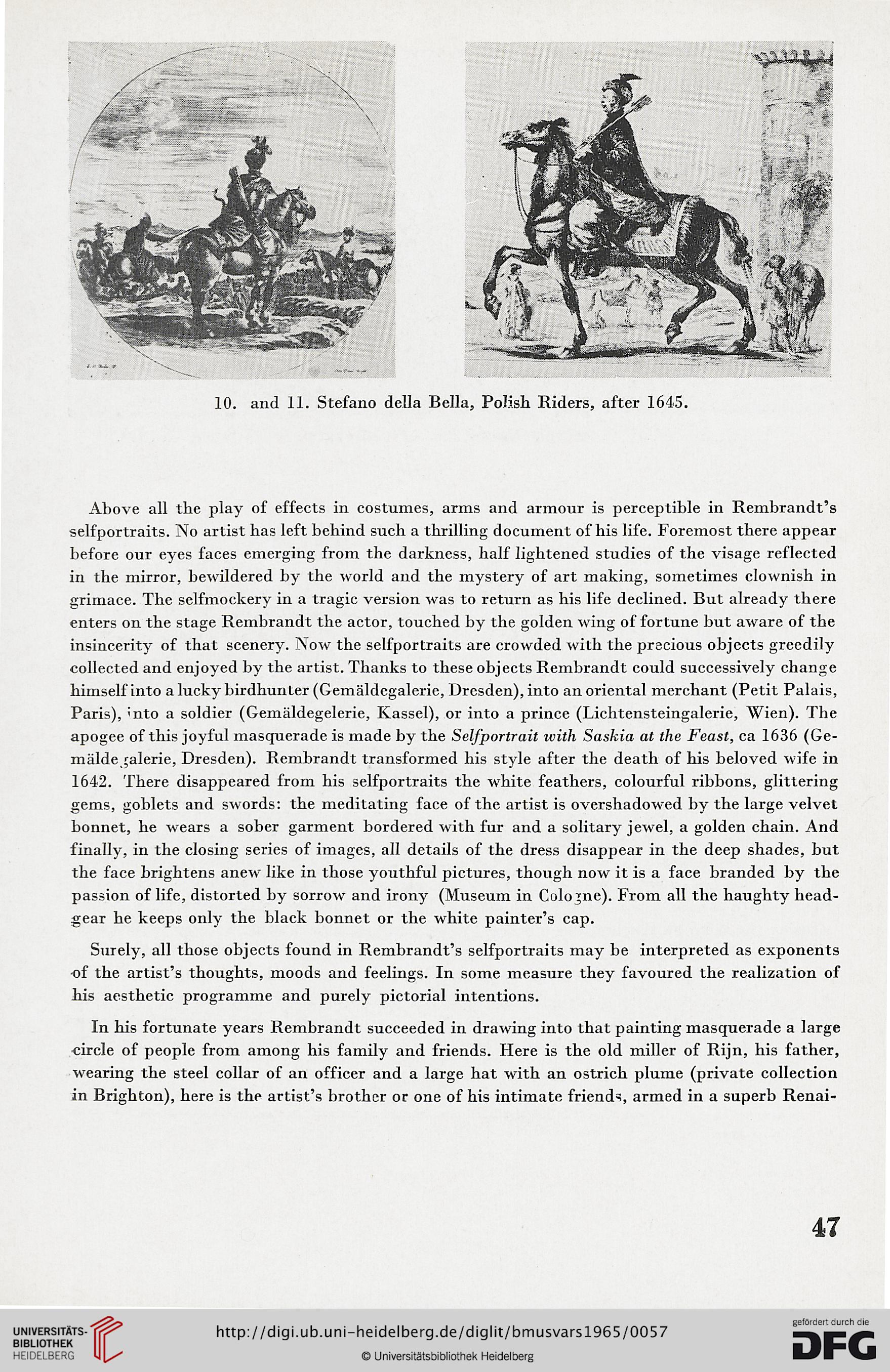10. and 11. Stefano delia Bella, Polish Riders, after 1645.
Above all the play of effects in costumes, arms and armour is perceptible in Rembrandt's
selfportraits. No artist has left behind such a thrilling document of his life. Foremost there appear
before our eyes faces emerging from the darkness, half lightened studies of the visage reflected
in the mirror, bewildered by the world and the mystery of art making, sometimes clownish in
grimace. The selfmockery in a tragic version was to return as his life declined. But already there
enters on the stage Rembrandt the actor, touched by the golden wing of fortunę but aware of the
insincerity of that scenery. Now the selfportraits are crowded with the precious objects greedily
collected and enjoyed by the artist. Thanks to these objects Rembrandt could successively change
himself into a lucky birdhunter (Gemaldegalerie, Dresden), into anoriental merchant (Petit Palais,
Paris), 'nto a soldier (Gemaldegelerie, Kassel), or into a prince (Lichtensteingalerie, Wien). The
apogee of this joyful masąuerade is made by the Sełfportrait ivith Saskia at the Feast, ca 1636 (Ge-
malde ęalerie, Dresden). Rembrandt transformed his style after the death of his beloved wife in
1642. There disappeared from his selfportraits the white feathers, colourful ribbons, glittering
gems, goblets and swords: the meditating face of the artist is overshadowed by the large velvet
bonnet, he wears a sober garment bordered -with fur and a solitary jewel, a golden chain. And
finally, in the closing series of images, all details of the dress disappear in the deep shades, but
the face brightens anew like in those youthful pictures, though now it is a face branded by the
passion of life, distorted by sorrow and irony (Museum in Colojne). From all the haughty head-
gear he keeps only the black bonnet or the white painter's cap.
Surely, all those objects found in Rembrandt's selfportraits may be interpreted as exponents
■of the artist's thoughts, moods and feelings. In some measure they favoured the realization of
his aesthetic programme and purely pictorial intentions.
In his fortunate years Rembrandt succeeded in drawing into that painting masquerade a large
circle of people from among his family and friends. Here is the old miller of Rijn, his father,
wearing the steel collar of an officer and a large hat with an ostrich plume (private collection
in Brighton), here is the artist's brother or one of his intimate friends, armed in a superb Renai-
47
Above all the play of effects in costumes, arms and armour is perceptible in Rembrandt's
selfportraits. No artist has left behind such a thrilling document of his life. Foremost there appear
before our eyes faces emerging from the darkness, half lightened studies of the visage reflected
in the mirror, bewildered by the world and the mystery of art making, sometimes clownish in
grimace. The selfmockery in a tragic version was to return as his life declined. But already there
enters on the stage Rembrandt the actor, touched by the golden wing of fortunę but aware of the
insincerity of that scenery. Now the selfportraits are crowded with the precious objects greedily
collected and enjoyed by the artist. Thanks to these objects Rembrandt could successively change
himself into a lucky birdhunter (Gemaldegalerie, Dresden), into anoriental merchant (Petit Palais,
Paris), 'nto a soldier (Gemaldegelerie, Kassel), or into a prince (Lichtensteingalerie, Wien). The
apogee of this joyful masąuerade is made by the Sełfportrait ivith Saskia at the Feast, ca 1636 (Ge-
malde ęalerie, Dresden). Rembrandt transformed his style after the death of his beloved wife in
1642. There disappeared from his selfportraits the white feathers, colourful ribbons, glittering
gems, goblets and swords: the meditating face of the artist is overshadowed by the large velvet
bonnet, he wears a sober garment bordered -with fur and a solitary jewel, a golden chain. And
finally, in the closing series of images, all details of the dress disappear in the deep shades, but
the face brightens anew like in those youthful pictures, though now it is a face branded by the
passion of life, distorted by sorrow and irony (Museum in Colojne). From all the haughty head-
gear he keeps only the black bonnet or the white painter's cap.
Surely, all those objects found in Rembrandt's selfportraits may be interpreted as exponents
■of the artist's thoughts, moods and feelings. In some measure they favoured the realization of
his aesthetic programme and purely pictorial intentions.
In his fortunate years Rembrandt succeeded in drawing into that painting masquerade a large
circle of people from among his family and friends. Here is the old miller of Rijn, his father,
wearing the steel collar of an officer and a large hat with an ostrich plume (private collection
in Brighton), here is the artist's brother or one of his intimate friends, armed in a superb Renai-
47




